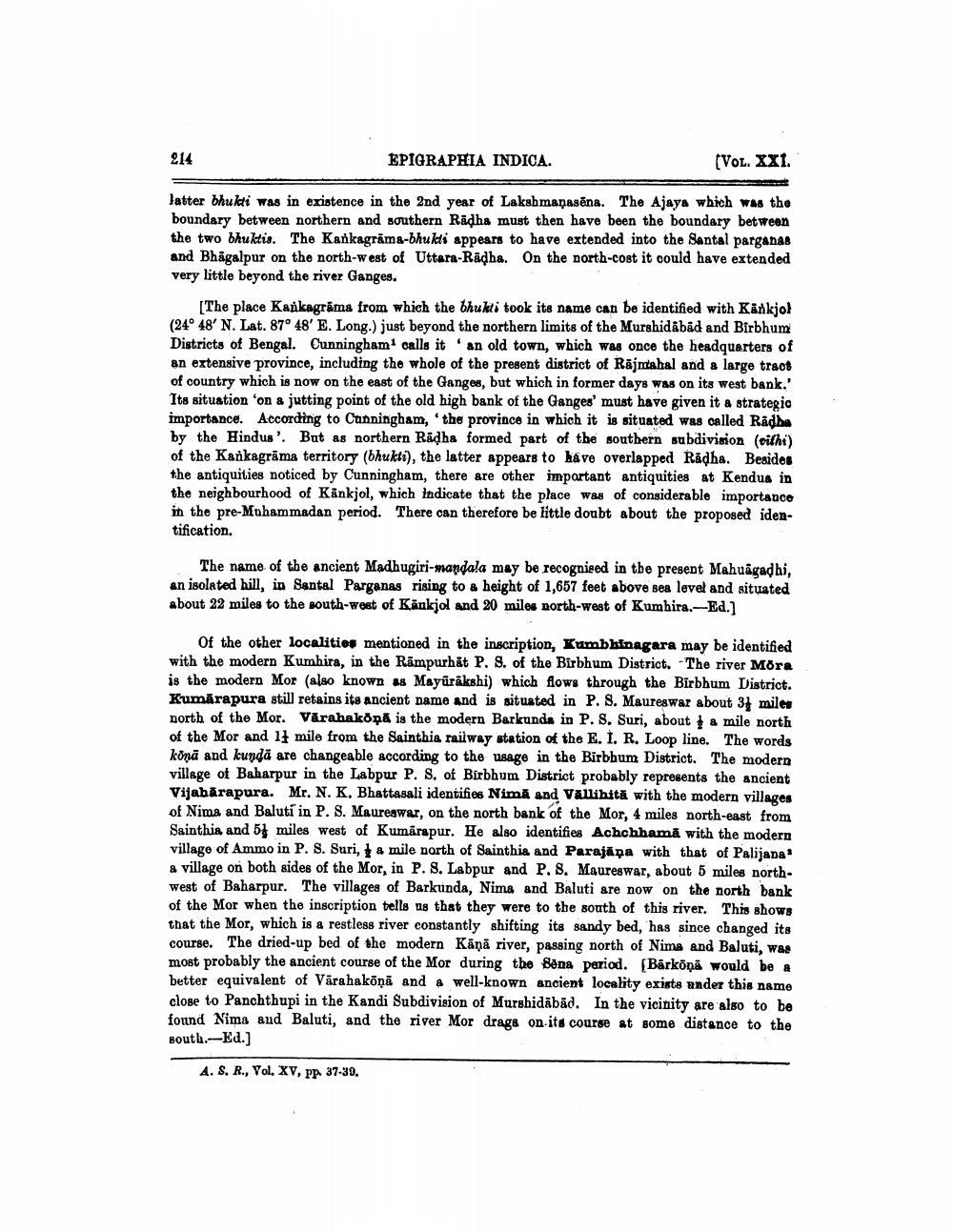________________
214
EPIGRAPHIA INDICA.
(Vol. XXI.
latter bhuki was in existence in the 2nd year of Lakshmanasēna. The Ajaya which was the boundary between northern and southern Rädha must then have been the boundary between the two bhuktis. The Kankagrama-bhuki appears to have extended into the Santal parganas and Bhagalpur on the north-west of Uttara-Rādha. On the north-cost it could have extended very little beyond the river Ganges.
[The place Kankagrama from which the bhukti took its name can be identified with Kankjol (24° 48' N. Lat. 87° 48' E. Long.) just beyond the northern limits of the Murshidabad and Birbhum Districts of Bengal. Cunningham calls it an old town, which was once the headquarters of an extensive province, including the whole of the present district of Rajmahal and a large tract of country which is now on the east of the Ganges, but which in former days was on its west bank.' Its situation on a jutting point of the old high bank of the Ganges' must have given it & strategic importance. According to Cunningham, 'the province in which it is situated was called Radha by the Hindus'. But as northern Rādha formed part of the southern subdivision (vilhi) of the Kankagrama territory (bhukti), the latter appears to have overlapped Radha. Besides the antiquities noticed by Cunningham, there are other important antiquities at Kendua in the neighbourhood of Kånkjol, which indicate that the place was of considerable importance in the pre-Muhammadan period. There can therefore be little doubt about the proposed identification.
The name of the ancient Madhugiri-mandala may be recognised in the present Mahuāgadhi, an isolated hill, in Santal Parganas rising to a height of 1,657 feet above sea level and situated About 22 miles to the south-west of Känkjol and 20 miley north-west of Kumhira.-Ed.]
Of the other localities mentioned in the inscription, Kumbhinagara may be identified with the modern Kumhira, in the Rāmpurhat P. S. of the Birbhum District. The river More is the modern Mor (also known as Mayürākshi) which flows through the Birbhum District. Kumārapura still retains its ancient name and is situated in P. S. Maureswar about 31 miles north of the Mor. Vārahakopā is the modern Barkunda in P. S. Suri, about a mile north of the Mor and 11 mile from the Sainthia railway station of the E. 1. R. Loop line. The words konā and kundă are changeable according to the usage in the Birbhum District. The modern village of Baharpur in the Labpur P. S. of Birbhum District probably represents the ancient Vijahārapura. Mr. N. K. Bhattasali identifies Nima and Vallihită with the modern villages of Nima and Baluti in P. S. Maureawar, on the north bank of the Mor, 4 miles north-east from Sainthia and 5% miles west of Kumarapur. He also identifies Achchhamă with the modern village of Ammo in P. S. Suri, a mile north of Sainthis and Parajāpa with that of Palijana a village on both sides of the Mor, in P. S. Labpur and P. S. Maureswar, about 5 miles northwest of Baharpur. The villages of Barkunda, Nima and Baluti are now on the north bank of the Mor when the inscription tells us that they were to the south of this river. This shows that the Mor, which is a restless river constantly shifting its sandy bed, has since changed its course. The dried-up bed of the modern Kāņā river, passing north of Nima and Baluti, wae most probably the ancient course of the Mor during the Sena period. [Barkon would be a better equivalent of Värahakāņi and a well-known ancient locality exists ander this name close to Panchthupi in the Kandi Subdivision of Murshidabad. In the vicinity are also to be found Nima and Baluti, and the river Mor drags on its courge at some distance to the south.--Ed.]
A. S. R., Vol. XV, pp 37-39.




